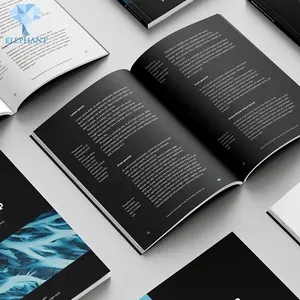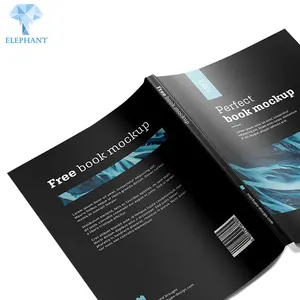
All categories
Featured selections
Trade Assurance
Buyer Central
Help Center
Get the app
Become a supplier

(92320 products available)



















































Suppliers provide laminated book covers in various types to cater to diverse needs and preferences. These types differ in terms of the level of protection they offer, their finish, and the methods used for lamination. Below are the most common types.
Self-adhesive laminated book covers are convenient for users who prefer a quick and easy application without the need for heat or special equipment. These covers have an adhesive backing protected by a release liner. peeling off the liner exposes the sticky side, which can be easily applied to books, textbooks, or notebooks. These covers are ideal for temporary or low-cost solutions. They provide a moisture-proof seal and allow for easy repositioning during application. However, their adhesive strength may weaken over time, reducing durability.
Heat-laminated covers offer a professional, durable protective solution by using heat and pressure to bond the laminate to the book. This method is commonly used in commercial settings where high-volume, long-lasting book protection is required. They are recommended for frequent handling as they provide excellent stiffness and a polished finish. Laminated book covers of this type are expensive and need special tools for the job, making them unsuitable for simple or small tasks.
These book covers are made of protective plastic layers bonded together using heat, resulting in a strong, moisture-proof seal. Often found in publishing and school markets, these covers provide long-lasting, water-proof protection ideal for books exposed to frequent use and varied environments. There are two finishes available: gloss for vibrant color enhancement and matte for a more subtle, non-reflective look. Covers like these are necessary to provide a strong, long-lasting bond in environments with critical humidity control needs.
Cold-laminated book covers are a prime solution for protecting books in humid or high moisture areas. These covers use a special adhesive that forms a strong bond when pressure is applied, instead of heat. They are best for environments like tropical climates or areas where books are frequently submerged, as they adhere firmly without the need for heat. Offering excellent tear resistance, cold-laminated covers are suited for both temporary and long-term protection of books.
Design plays an important role in the selection of laminated book covers as it impacts the aesthetic value and functional usability of the product. These designs help maximize the diverse decorative and functional demands the coverings must fulfill.
Custom printed laminated covers allow users to personalize the cover with unique graphics, colors, and branding. This option is particularly appealing to businesses and educational institutions wishing to create distinctive books or promote a brand. Companies print on the laminate's interior or exterior for sharp graphics and text. The design flexibility offered includes various finishes—glossy, matte, embossed—and multiple shapes and sizes, which can help forge a strong visual identity for any purpose, be it business, education, or publishing.
These are shaped, dimensional, or fitted laminated covers, offering superior protection and appeal. Its application is useful for special designs such as curved books or unique shapes. Materials like vinyl give enough flexibility for intricate cuts and patterns. They protect as intended, due to their tailored shape, and look good doing it. Common usage is in niche publishing or for special edition books, where distinctiveness is a top priority. Under this technique, durability is not sacrificed for design, as the robust laminate still protects.
Textured Laminated Covers Incorporating a tactile element through embossing, debossing, or graining, textured laminated covers add a three-dimensional feel that enhances grip and visual appeal. This type of design is often used for high-end publications or special edition books where luxury and quality are paramount. Materials like soft-touch or matte laminate provide a rich feel that not only beautifies but also strengthens the cover, making it highly resistant to wear.
These covers include elements like pockets, flaps, and die cuts that allow for insertables, charts, and other types of interactive Covers offer an added layer of engagement and functionality, making them ideal for educational books or manuals requiring additional materials. Customization options are plenty, including varying laminates. This increases their use in active learning environments where books are regularly handled and need to be durable and versatile.
Laminated book covers are essential to the publishing, education, and corporate training industries. They enhance the longevity and appearance of books while showcasing professional standards in quality, increasing demand among consumers and businesses.
Increased Durability and Professional Appearance
Laminated book covers enhance the lifespan and the values of publications, which is advantageous to publishers looking to increase profits via lower production costs. They defend against staining, wetting, and the general tearing caused by many hands. This handsome treatment causes a positive perception among consumers who feel valued by quality when purchasing books and manuals. Increased length of use brings fewer repurchases, which further boosts up publishers' competitive edge over rivals. Protective wear further aids visually appealing books, which may lead to more sales. Thus, laminated book covers help business by servicing a dual objective: increasing durability and enhancing the book's value.
Cost Efficiency and Brand Visibility
Laminated covers save costs by preventing the need for expensive rebindings or replacements, which is economically beneficial to schools and libraries. By extending a book's lifespan, these covers help institutions derive more value from each title. Moreover, books enhanced with lamination serve as free advertising when in use, attracting sponsors and boosting brand recognition. Schools appreciate both their cost-saving associated with reduced repurchases and the promotional potential of their libraries.
Corporate training programs and professional reference materials often undergo frequent usage in demanding environments. Laminated book covers become vital in safeguarding investment as they protect against spills and any form of physical damage. The glossy finish improves the cover, enhancing information presentation. For expensive manuals and reference guides, laminated covers ensure that the materials remain useful over time, which is imperative for maximal utilization. In industries where training is critical, and resources should remain in good condition, laminated covers are essential for protecting long-term learning implements.
In the marketing field, laminated book covers have great appeal for catalogs, look books, and promotional guides. Companies want to leave behind the right impression, so marketing materials must be attractive and durable. Custom-finish lamination creates appealing materials that represent a corporation's quality. When flip-through books or hand-outs are protected by lamination, individuals perceive the organization positively. Exposure leads to brand recognition for promotional materials well designed, and this may lead to more sales. In this way, laminated book covers help make marketing effective by protecting and beautifying brochures.
The educational sector is where laminated book covers show their worth as they protect textbooks, reference works, and academic journals. They additionally defend against such harm resulting from spilling substances or handling, which is greatly appreciated in libraries and classrooms. Further, lamination support the book's visual appeal and ensure that learning materials exist as intended throughout the academic year, which is advantageous. Schools do not incur costs associated with replacing damaged books, and therefore, laminated covers represent the investment. These covers are essential for maintaining educational integrity and safeguarding learning resources.
Choosing the right protective film for books involves considering several factors, such as the level of use and the environment in which the books will be housed. Protective film for books requires careful consideration of many factors, such as durability, the degree of usage, the environment of the books, and the type of protection required. Below are some of the factors.
Consider how often the books will be used or handled when selecting a laminated cover. Choose thicker, high-quality laminates with greater levels of wear for frequently used textbooks, manuals, or books in a library. In these cases, additional protection lamination, such as self-adhesive or heat-laminated covers, is necessary to survive the wear. For lower-use volumes like special collections or reference works within academic libraries, lighter laminated covers will be sufficient. Weighing the intensity of use assists in selecting a proper level of lamination for diverse books.
The type of laminated book cover chosen should cater directly to the specific environment and purpose of the material. Adhered laminates are quick to apply and perfect for an inexpensive, temporary fix. Heat-laminated and cold-laminated covers are for permanent applications that require a professional look or occur in high-humidity areas where adhesive strength must endure. Thermal lamination especially suits archival environments where critical control of humidity occurs. Selecting the appropriate laminate type will effectively meet the demands of diverse conditions.
Suppliers can add value by providing several design options like colors, textures, finishes, and interactive features. Publishers, schools, or corporations may wish to present a professional image or fit special or standard needs. More than one finish is available for lamination: glossy, which enhances color, and matte, which is less reflective. Suppliers can also provide die cutting for special shapes or textured lamination for a tactile effect. In marketing or publishing, this differentiation may be crucial.
While cost is important in selecting laminated covers, it goes hand in hand with the expected durability. Choosing a lower-quality laminate can result in greater costs in future due to lesser protection and quicker wear of books. In contrast, a high-quality laminated cover could ensure much longer life and protection for the book, thus saving money for the buyer in the long run. Books of higher value, whether financially or intellectually, should receive special protection in the form durable laminated covers. Balancing initial cost and long-term durability will benefit the books over time.
A1: Laminated book covers are usually made of thick paper, cardstock, or plastic laminate. Laminating films come in many variations, but they mostly come in polypropylene, polyethylene, and vinyl.
A2: In the education sector, laminated book covers increase the lifespan of textbooks and reference materials, decreasing costs for institutions by reducing the need for replacements. In marketing, they stand out as advertising tools, increasing brand recognition due to their durability and attractiveness.
A3: Most modern laminated materials have recycled variants and are recyclable, although the environmental impact is less than unprotected books. Some companies are also using biodegradable laminates.
A4: Most laminated covers are not reused; cold-laminated and thermally-laminated covers are sometimes detached and reused but is uncommon. As for recycling, it is often a challenge due to plastics used, but many choose environment-friendly options that are recyclable.
A5: A matte finish laminated cover is a suitable option because it is less reflective than other finishes. One of the main benefits of matte lamination is that it avoids glare, allowing for easy viewing while also enhancing the texture and colors.